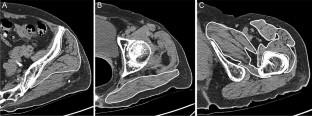International Orthopaedics ( IF 2.0 ) Pub Date : 2022-09-20 , DOI: 10.1007/s00264-022-05563-2 Junsheng Leng 1 , Xiao Chang 1 , Qiushi Bai 1 , Yun Wang 2 , Xingyu Liu 2 , Jia Zhang 1 , Peng Gao 1 , Yu Fan 1 , Xiongfei Zou 1 , Hengyan Zhang 1 , Baozhong Zhang 1

|
Purpose
Apart from bone conditions, muscle and soft tissue parameters might also influence hip fractures. We aimed to evaluate the association between hip muscle and trochanteric soft tissue parameters and hip fractures.
Methods
We retrospectively reviewed 60 patients with hip fractures and 114 controls without hip fractures. Cases and controls were matched for age, sex, and body mass index using propensity score matching. Muscle cross-sectional area (CSA), mean attenuation, and fatty infiltration rate (FIR) (proportion of intramuscular fat content) were measured on CT images for the gluteus maximus, the gluteus medius/minimus, and the anterior and medial compartments of the upper thigh. Trochanteric soft tissue thickness (TSTT) and femoral neck attenuation were also measured. Univariate and multivariate analyses were conducted to identify potential risk factors of hip fractures.
Results
Patients with hip fractures had significantly lower femoral neck attenuation, TSTT, and CSA of the gluteus maximus and anterior compartment than controls. FIR of all hip muscle groups were significantly higher in hip fracture patients than controls. Multivariate analysis revealed that every 1% increase in FIR of medial compartment independently increased the odds of hip fractures by 23.7% (OR = 1.237, 95% CI = 1.093–1.401) and every 1 cm longer TSTT independently decreased the odds by 32.8% (OR = 0.672, 95% CI = 0.477–0.946).
Conclusion
Fatty infiltration of hip muscles can better discriminate hip fractures than muscle area. Increased TSTT is independently associated with low fracture risk.
中文翻译:

髋部肌肉脂肪浸润和大转子软组织厚度与老年人髋部骨折相关
目的
除了骨骼状况,肌肉和软组织参数也可能影响髋部骨折。我们旨在评估髋部肌肉和转子软组织参数与髋部骨折之间的关联。
方法
我们回顾性分析了 60 名髋部骨折患者和 114 名无髋部骨折的对照患者。使用倾向得分匹配,将病例和对照的年龄、性别和体重指数相匹配。在臀大肌、臀中肌/臀小肌以及臀部前部和内侧间室的 CT 图像上测量肌肉横截面积 (CSA)、平均衰减和脂肪浸润率 (FIR)(肌肉内脂肪含量的比例)大腿上部。还测量转子软组织厚度 (TSTT) 和股骨颈衰减。进行单变量和多变量分析以确定髋部骨折的潜在危险因素。
结果
与对照组相比,髋部骨折患者的股骨颈衰减、TSTT 和臀大肌和前筋膜室的 CSA 显着降低。髋部骨折患者所有髋部肌肉群的 FIR 均显着高于对照组。多变量分析显示,内侧间室 FIR 每增加 1%,髋部骨折的几率独立增加 23.7%(OR = 1.237,95% CI = 1.093–1.401),TSTT 每延长 1 cm,独立地降低几率 32.8%( OR = 0.672,95% CI = 0.477–0.946)。
结论
臀部肌肉的脂肪浸润比肌肉区域更能区分髋部骨折。增加的 TSTT 与低骨折风险独立相关。











































 京公网安备 11010802027423号
京公网安备 11010802027423号